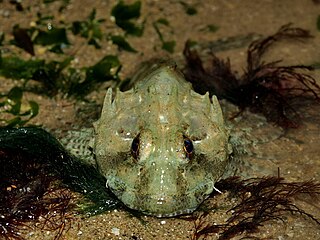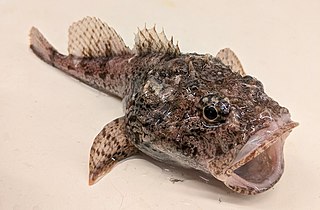The Abyssocottinae are a subfamily of ray-finned fishes in the family Cottidae, the sculpins. They are known commonly as the deep-water sculpins. The entire family is endemic to Lake Baikal in Siberia.

The spoonhead sculpin is a species of freshwater ray-finned fish belonging to the family Cottidae, the typical sculpins. This species is widespread in northeastern North America.

Cottus is a genus of the mainly freshwater ray-finned fishes belonging to the family Cottidae, the typical sculpins. They are often referred to as the "freshwater sculpins", as they are the principal genus of sculpins to be found in fresh water. They are native to the Palearctic and Nearctic.

Comephorus, known as the golomyankas or Baikal oilfish, are a genus comprising two species of peculiar, sculpin fishes endemic to Lake Baikal in Russia. Comephorus is the only genus in the subfamily Comephorinae. Golomyankas are pelagic fishes and the main food source for the Baikal seal.

The Pacific staghorn sculpin is a species of marine ray-finned fish belonging to the family Cottidae, the typical sculpins. This species is found in the eastern Pacific Ocean. It is the only species in the monospecific genus Lepidocottus.
The Shoshone sculpin is a species of freshwater ray-finned fish belonging to the family Cottidae, the typical sculpins. It is It is endemic to the United States. It inhabits spring systems in the Thousand Springs formation near Hagerman, south-central Idaho. It reaches a maximum length of 9.0 cm. The specific name honors Charles Wilson Greene who was an instructor in physiology at Stanford University and was on the expedition on which the type was collected from the Thousand Springs on the Snake River, near mouth of Salmon Falls River in Gooding County, Idaho.

The fourhorn sculpin is a species of ray-finned fish belonging to the family Cottidae, the typical sculpins. This species has a Holarctic distribution and can be found in marine, brackish and fresh waters.

The long-spined bullhead, also known as the long-spined sea-scorpion, and the long-spined scorpion fish is a coastal fish of the sculpin family Cottidae, inhabiting marine waters of Europe.
Cottus scaturigo, the Timavo sculpin, is a species of freshwater ray-finned fish belonging to the family Cottidae, the typical sculpins. It is endemic to the Timavo Spring in Italy. This species was described as a separate species from the European bullhead in 2005 by Jörg Freyhof, Maurice Kottelat and Arne W. Nolte. However, the Catalog of Fishes treats this taxon as a synonym of Cottus metae, although FishBase treats it as a separate species. The specific name scaturigo means “spouting water”, i.e. a spring, an allusion to the Timavo Spring.
Abyssocottus is a genus of ray-finned fishes belonging to the family Cottidae, the typical sculpins. These sculpins are endemic to Lake Baikal in Russia.
The Blackfin hookear sculpin is a species of marine ray-finned fish belonging to the family Cottidae, the typical sculpins. It is the only species in the monospecific genus Artediellichthys. This species is found in the northern Pacific Ocean. It occurs at depths of from 200 to 815 metres. This species grows to a total length of 13.7 cm (5.4 in).
The hairhead sculpin is a species of marine ray-finned fish belonging to the family Cottidae, the typical sculpins. It is the only species in the monospecific genus Trichocottus.
Batrachocottus is a genus of freshwater ray-finned fishes belonging to the family Cottidae, the typical sculpins. These fishes are endemic to the Lake Baikal watershed in Russia.

Cottocomephorus is a genus of freshwater ray-finned fishes belonging to the family Cottidae, the typical sculpins. This genus is endemic to Lake Baikal and its surrounding tributaries in Russia. They have relatively large pectoral fins and reach up to 22 cm in total length. They are an important food for the Baikal seal, during the winter second only to the golomyankas.
The stone sculpin is a species of cottoid fish endemic to Russia, where it is found in Lake Baikal and surrounding tributaries as well as the Gramninskie Lakes, Lake Verkhnaya Agata and the Enisei River and various lakes in Tuva. This species is the only recognized member of its genus.

The spinyhead sculpin is a species of marine ray-finned fish belonging to the family Psychrolutidae, the fatheads. This species is found in the northern Pacific Ocean. This species is the only species in the monospecific genus Dasycottus.
Procottus gotoi is a species of ray-finned fish belonging to the family Cottidae, the typical sculpins. It is endemic to Lake Baikal in Siberia. This species was first formally described in 2001 by Valentina Grigorievna Sideleva.
The bighead sculpin is a species of sculpin fish that is endemic to the Lake Baikal watershed in Siberia, Russia. It typically lives on rocky bottoms, often in places with sponges, at depths of 5 to 70 m (16–230 ft), but can occur as deep as 120 m (390 ft). Its colour varies from grayish to brownish or greenish depending on the bottom type. It can reach up to 22 cm (8.7 in) in length, but most are 13–16 cm (5.1–6.3 in). It feeds on a wide range of smaller animals such as young fish, insect larvae, amphipods, molluscs and oligochaetes. Breeding is in the spring where the female lays 618 to 1622 eggs, which are guarded by the male.
The Sakhalin sculpin is a species of amphidromous ray-finned fish belonging to the family Cottidae, the typical sculpins. It is found in eastern Russia to northern Japan. It reaches a maximum length of 20.8 cm. The Sakhalin sculpin was first formally described in 1904 by the Russian zoologist Peter Yulievich Schmidt with its type locality given as the Lyutoga River on Sakhalin. This species is sometimes placed in the subgenus Cephalocottus. The specific name is a misspelling of Ambystoma, the axolotl combined with opsis, meanning "having the look of", and Schmidt described it as having a head that is “strongly dorsoventrally depressed, wide, nearly flat dorsally, abruptly sloping laterally, similar to the head of an axolotl” (translation).
Cottus szanaga is a species of freshwater ray-finned fish belonging to the family Cottidae, the typical sculpins. It is found in Mongolia and Russia. It reaches a maximum length of 8.2 cm. This species was first formally described in 1869 by the Polish naturalist Benedykt Dybowski with its type locality given as the Onon River in the Amur River drainage basin of Russia. The specific name szanaga is derived from Szanaga-sagasu, meaning "spoon fish" the Buryat dialect word for this fish n the Amur basin.








